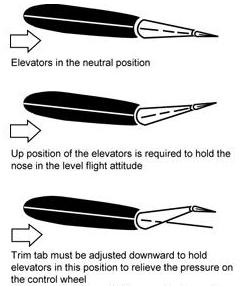
In the previous discussion, the one speed or angle of attack concept was used to explain how longitudinal stability was attained. It is important for the pilot to know that the airplane is stable at various speeds or angles of attack, not just one. The controls, which allow the pilot to depart from the one speed or angle of attack concept or the controls used to give the pilot longitudinal control around the lateral axis, are the elevators and the elevator trim tab. [Figures 1-25 and 1-26]
 |
|
|
| This forces the tail down, increasing the angle of attack
of the wings.
Conversely, if forward pressure is applied to the elevator control, the elevators are lowered, decreasing the horizontal stabilizer’s negative angle of attack and consequently decreasing the downward force on the tail. This decreases the angle of attack of the wings. [Figure 1-25] The elevator trim tab is a small auxiliary control surface hinged at the trailing edge of the elevators. The elevator trim tab acts on the elevators, which in turn acts upon the entire airplane. This trim tab is a part of the elevator but may be moved upward or downward independently of the elevator itself. It is controlled from the cockpit by a control which is separate from the elevator control. The elevator trim tab allows the pilot to adjust the angle of attack for a constant setting and therefore eliminates the need to exert continuous pressure on the elevator control to maintain a constant angle of attack. |
 |
|
|